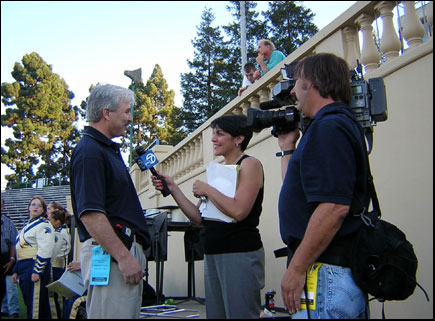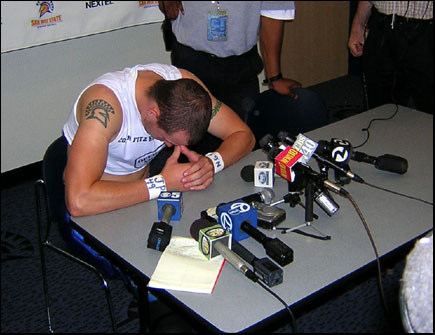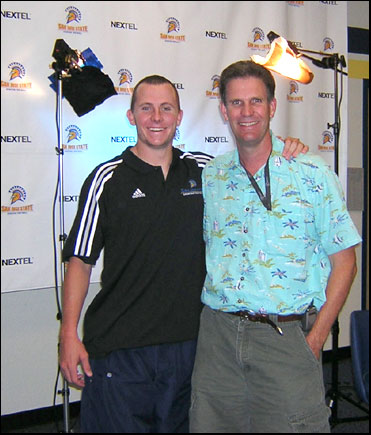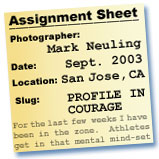Profile
in Courage
By Mark Neuling
Field Camera Operator for TechTV
Slug: San Jose, California
Sept. 2003
Wednesday
For the last few weeks I have been in the zone. Athletes get
in that mental mind-set where they can seemingly do no wrong. Every
pass they throw somehow threads its way to the receiver; every shot
they take hits nothing but net. A hanging curve to Barry Bonds
looks like a softball pitch at the church picnic destined to be parked
in the bleachers 420 feet away.
Maybe it was because I was in a funk about work that the gods decided
to smile on me. For the last few weeks the stories I’ve
been assigned have just been terrific. Good, solid stories:
more than just the usual forest of talking-heads that so prevails
in television news. It’s easy to find the zone
when the subject matter is so interesting and characters are so compelling. The
technical theatrics of photography become secondary to the story
itself.
An older and wiser photographer once wrote us from his oracle that
we have one of the best jobs in the world. We get to go places
and meet people that other folks only get to dream about, and we’re
given the opportunity to tell their stories.
In the computer my assignment for Thursday read: [Goldman/NCAA
amputee/San Jose/ 4-8 p-m]. Ah ha, a story I’m vaguely
familiar with.
Several years back a football player at San Jose State University
had a horrible accident and broke his leg during a game. Infection
set in and after several days the leg had to be amputated. He
vowed to play again and has been practicing with a prosthetic leg. I
guess he was about to make his comeback. When our assignment
editor lists the shoot-schedule, the times indicate when we are to
leave and approximately when we’re expected back. The
round-trip to San Jose takes about two hours of driving time, realistically
I have only a couple of hours to shoot what we need. I figure
we’ll arrive at the end of practice, shoot some b-roll and
get an interview with the player and his coach. Of course things
don’t always work according to plan.
Thursday
Since I’m ending my shift three hours later than normal today
I come in later than usual. I get to my desk five minutes early
and already there is a producer circling. He needs to leave
ASAP for a shoot scheduled unbeknownst to us for 11 am. We’re
already late and we haven’t even left the building. Long
story short –the shoot gets cancelled.
When I return, the assignment editor asks if I can stay a little
later than 8pm in San Jose that evening. It turns out that
there may be a press conference after the game and that we need to
cover it. This may be our only chance to speak with the player
and his coach. Press conference, game, what’s up? College
football is not played on Thursday nights. I haven’t
shot any football in nearly two years, and that was high school. I
can’t remember the last time I shot any college ball.
The assignment editor asks me to call Jim Goldman for the lowdown.
Jim and I go way back, close to the start of our careers. We
don’t work together often and when we do we make an unlikely
duo. He’s an East Coast Ivy Leaguer, I’m West Coast,
state-college educated. I’m probably a dozen years older
and he’s probably a dozen inches shorter. But he’s
about the best reporter I’ve ever worked with; and he picks
up the tab for lunch.
A shoot, especially big ones, are very similar to football games. You
need a game plan, you want to run certain plays, passes can be dropped,
and sometimes you have to punt. A reporter is like the head
coach. He’s the one calling the plays. The photographer
is like the quarterback. He’s the one that executes them. Jim
discusses his game plan with me. We’ll arrive around 5pm. The
game starts at 7pm. We’ll get some b-roll of our subject
warming up. He’s hoping to get an interview with the
prosthetist that designed Neil’s leg. Maybe we’ll
get the team trainer as well. Most importantly we need shots
of the player in the game. If we get enough during the first
half we may not need to stay any later. Then, on Friday we’ll
drive back down to San Jose for a one-on-one interview with the athlete;
we’ll only have a 20- minute window to do it in. The
story is due to run Monday night. I let the assignment editor
know that I may be staying quite a bit later than eight. She
nods and I break for lunch. I still have two more shoots scheduled.
I meet up with Jim about 20 minutes later than planned. He
hands me my field pass and we walk through the North gate onto the
field at San Jose State University. Jim has been busy working
his contacts. The game is to be televised by Fox Sports; we’ll
get an ISO dub after the game. The prosthetist is confirmed
to give us an interview prior to the game; he’ll have an example
of the prosthesis that the State player will be wearing. We’ll
also get footage of the actual accident from one of the local stations. Jim
never ceases to amaze me. But this is all a part of his game
plan.
We
wait on the ramp that the players jog down to get to the
field. They
dribble out in two’s and three’s. The
visiting team players take the field for their warm-ups.
They seem a
lot bigger than the San Jose State players. Pretty
soon a knot of cameras forms around a cluster of blue jerseys. I
pan with them as they go by. In my viewfinder I see the
name PARRY and the number 32.
Seven or
eight television cameras and a nearly equal number of still photographers
line the North end zone in the waning light of this Indian summer
evening. All have their glass trained on a six-foot one,
177 pound, fifth year senior as he goes through warm- ups alongside
the other players. |

Photographers
waiting for Neil Parry to take the field before San
Jose State's game against Nevada.
© Mark Neuling 2003. |
|
The
only difference, he is wearing an artificial leg. One
October evening nearly three years ago, a teammate rolled into
Neil Parry, breaking his right leg. The
leg had to be amputated below the knee. Neil endured 25 operations,
numerous prosthetic legs, and mountains of red-tape in order to
play football again. Should he line up on the punt return
team this evening he would be the first non-kicker amputee to ever
play
in
a Division-I NCAA college football game.

Prosthetist
Mike Noller being interviewed by a news crew from
KGO-TV.
© Mark Neuling 2003 |
|
The
team huddles up and returns to the field house. Jim has found
Mike Noller the prosthetist who designed Neil’s fiber-carbon
leg. He gives us a quick rundown on the technology behind
Neil’s prosthetic leg and some insight into Neil’s
return journey to the gridiron. A CBS News crew
piggy-backs on our interview. Other crews also interview
Mike; this is the real crux of our story and Jim found it first. |
We
notice a cluster of television crews gathered around Neil’s
parents up in the bleachers. Jim fingers the yellow field
pass tied to his jeans. “We were given these with
the understanding that we would leave Neil’s parents alone,” he
tells me. We
briefly discuss our options and decide not to bother going in
the stands, why risk getting kicked out.
San Jose State’s opponent this night is the Nevada Wolf Pack.
Even though we don’t need any game highlights I decide to shoot
some anyway. You never know. I continue in the zone I’ve
been in for the last two weeks. I can sense touchdowns a play
or two early. The scoring runs come my way. Nevada scores
early and often, they don’t punt at all in the first half.
The third quarter passes, San Jose State trails by a couple of
touchdowns. Finally,
early in the fourth quarter Nevada is stopped and they have to punt. Neil
Parry sprints onto the field and lines up at his left tackle position. He
makes contact with one of the Nevada players at the line of scrimmage
and trails the play down the field. The punt return only goes
for two yards; Neil trots off the field to the applause of the crowd
and the congratulations of his teammates. It is the
only play that he is involved in that night.
After the game a long line of journalists forms outside the field
house. When we are let in you would have thought that gold
had just been discovered inside. A few friends and family members
of the players and coaches watch as the media hoard streams past;
their mouths are agape as we invade the building with our cameras,
tripods, boom mics and tape recorders. They stare at us in
disbelief.
We
are led into a large meeting room. There, sitting at a table
head in his hands sits Neil Parry. The television crews
start to set up their cameras in a semi-circle in front of
him. Some producer screams that he is from CBS News and
that he has a tripod coming. I quietly go about my business
and set up my sticks next to him. Another shooter says
to no one in particular for everyone to calm down, and then
moves aside some tables to give us more room. The tripod
from CBS never does show up. |

Neil Parry awaiting questions from
the media.
© Mark Neuling 2003 |
|
Somehow
Jim gets in the first question. It is evident that
Neil feels pretty dejected. His answers are brief; he’s
disappointed he didn’t play more; the leg feels fine,
but his team lost. That pretty much sums it up. Jim
and I wrap it up and make our plans for Friday.
Friday
I arrive at the field house a few minutes early; a sat-truck is
parked out back. It’s hot and the campus is quiet save for a
few of the athletes lounging about. I spot the Sports Information
Director and he directs me to park in a loading zone. I tell
him where I’m from, he says he’s been trying to get in
touch with Jim all day and wants to know if we still want our four
o’clock slot. “Oh yeah,” I tell him. I
call Jim and leave him a message, “I’ve arrived and I’m
going to start setting up.”

Some
of the media gathered to interview Neil Parry after his
return
to football.
© Mark Neuling 2003 |
|
Neil
sits in almost exactly the same spot he was in the night
before. A
crew from ESPN’s SportCenter is furiously trying to get
set up for a live-shot. There are problems with one of
the IFB’s, the cameraman is another old friend of mine;
he can’t hear the director back in Bristol, just the
truck operator. I quietly go about setting my lights and tripod
up. Neil is drained; he has been giving interviews all
day, starting with the Today Show. He still has a banquet
to attend that evening and an interview with Paula Zahn of
CNN. His fifteen minutes of fame is going to stretch
well beyond 24 hours.
The ESPN interview begins and Neil’s answers sound about the same as the
one’s he’d given the night before. At one point during a
break he asks the SID about all the attention his parents had gotten in the
stands
the previous evening. He sounds perplexed by it all. |
Finally
it’s my turn, except that my reporter hasn’t
arrived. The other crew breaks down and I set up, Neil
takes a break at a computer. The SID thinks Jim may
make it down by four o’clock, I wonder if he’s
stuck in traffic. If
he doesn’t show soon I’m going to do the interview
myself.
By 4:05 I’ve placed a microphone on Neil, locked my camera
down and started the interview. It’s just us, the SID
and one of Neil’s friends. We don’t talk
about the game at all. I ask him about his recovery, his prosthetic
leg and what his plans for the future are. I find him to be
warm, articulate and surprisingly modest despite the media barrage
he’s endured the past several days. I look down at my
watch, it’s nineteen minutes past four; we wrap a minute
early.
As I’m loading the gear into the car I get a call from Jim. The
news department had decided to air the piece on that night’s
newscast; he’d been editing all day and had just gotten my
message. He had given the assignment desk the heads-up that
he didn’t need the shoot, but the assignment editor was out
sick and I never got word of the cancellation. My entire
afternoon of work was for naught.
But
it wasn’t. Even though my interview may never see
the light of day I felt good about it. And I got to meet
an extraordinary young man. Why would an amputee who
was a walk-on player to begin with, endure the operations,
hard work, doubts and bureaucratic hassles just to play football
again? It has to be for more than merely the love of
the game. No words of mine and certainly no pictures
can speak of the guts, determination and courage of Neil Parry.
The sage was right; this is one of the best jobs in the world. |

Neil Parry - San Jose State University, class of '04.
The author,
class of '77.
© Mark Neuling 2003 |
|
© Mark Neuling 2003
The opinions expressed are solely those of the author.
Email info: markneuling@techtvcorp.com
TechTV is the world’s leading cable and satellite television channel
covering technology news, information, and entertainment from a consumer,
industry, and market perspective 24 hours a day. Available in more
than 75 million households across 70 countries, TechTV is also the world’s
largest producer and distributor of programming about technology.
Copyright TechTV 2003 TechTV Inc. All rights reserved.
|






